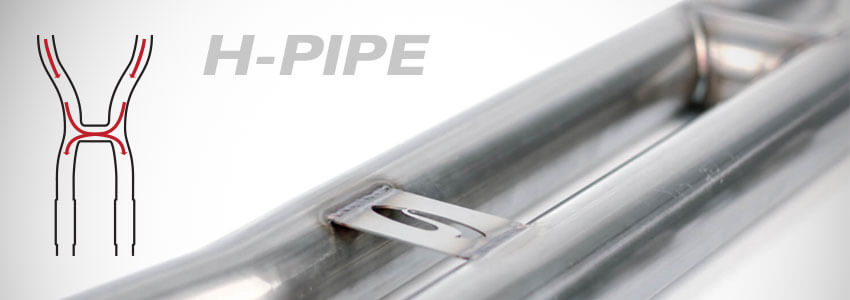Throughout Mustang history, the most notable cue to what makes a Mustang a Mustang is the exhaust note.
For more than 55 years, America's original pony car has helped automotive enthusiasts achieve the
ultimate driving experience. If automotive history tells us anything, it is clear that the driving
experience is what motivates companies like Ford Motor Company to push the boundaries of technology,
engineering, innovation, and commitment to going above and beyond what enthusiasts expect. Since Carroll Shelby put his hands
on the original pony car, companies like Steeda have pushed the envelope to create
performance parts to aid the Mustang in terms of horsepower, lowering springs, suspension, and, most
importantly, exhaust.
From the original 1960s era pony to the modern S550 Mustang, the exhaust system has remained the same in
terms of components. The main change has been in terms of catalytic converters, resonators, and
mid-pipes due to the regulations and systems needed for modern stallions. Since the early 1990s,
enthusiasts have been ensuring their Mustang can roar the sounds of freedom. Now, if you're a veteran
Mustang enthusiast, you know that sound is very subjective, it is why companies like Steeda offer a
selection of X-Pipes as well as H-Pipes to create different tones
in exhaust notes. Every enthusiast
will have a particular goal in the way they want their pony to sound like. Throughout this article, we will give a complete breakdown of the differences between an X-Pipe and
H-Pipe on why each one will fit a specific enthusiastic goal! One of the great things about the entire exhaust system within the Mustang is creating the variations of
tone from a Ford V8 engine and the ability to add horsepower on-demand with ease. Since Steeda's
inception, we have been emphasizing form and function at the core of what we do. One of the very things
we are proud of is the ability to create purposeful X-Pipes to not only add volume, sound, and
horsepower but the ability for your Mustang engine to run more efficiently. An X-Pipe is the most common mid-pipe among enthusiasts; the reason for this is due to the incredible
tone it gives to your Mustang, which your the least amount of chance to lose power when going against an
h-pipe. Suppose you are the type of enthusiast looking to make your Mustang sound like the hell horse.
In that case, it deserves with the combination of axle-back mufflers and
long-tube headers creating
the legendary sounds of American muscle for miles around. While combining all of these, you will
aid your Mustang in gaining more horsepower, torque, reliability, and breathe better.
An X-Pipe design is influenced by crossing over in an " X" design, what this does is allow for the
exhaust gases
to flow more effectively. From a sound standpoint, they usually project a high pitch compared to an
H-Pipe and give off a generally louder projection. Years ago, you would typically find X-Pipes European
vehicles, but they have made their way over to American Performance vehicles like the Mustang within
recent memory. If you're the type of Mustang owner who wants their pony to be loud and proud while
maintaining horsepower at the highest RPM levels, then an X-Pipe is for you! Unlike an X-Pipe, an H-Pipe is more
for the enthusiasts who want to have the old school type of sound
that comes from the original Mustang. You're probably asking why an H-Pipe gives off the old school
muscle exhaust note? The reason behind this is because they are essentially two separate pipes while
having a crossover pipe connecting them come together to create the " H." One of the most considerable
advantages
the H-Pipe has over the X-Pipe is it will help your Mustang engine create more low-end torque
that the pony is known to have. So if you intend to make a torque monster from your Mustang to
take to the drag strip. The keys to an H-Pipe are the following: allowing the exhaust gases to equalize pressure in
the
crosspipe, creating power on the low end vs. the high end, and a smoother exhaust note that
is much
deeper than an X-Pipe. The H-Pipe's downfall is the design; because of the crossover pipe
innates how
the exhaust gases flow, whereas the X-Pipe flows exhaust
gases much more efficiently. You will need to
ask yourself if you are the type of enthusiast who enjoys a deeper tone and more torque than an H-Pipe
is for you! Every Mustang enthusiast comes at a crossroads where they will decide how they want their
pony to sound
the exhaust note is very subjective. So you will have to ask yourself some straightforward
questions,
what is the objective you plan to achieve with either an X-Pipe or an H-Pipe, and the type
of exhaust
note your desire. On the other hand, your aim for horsepower and torque can play a
significant factor
because all of your other supporting modifications will play a role in how much power your
stallion
makes. With so many options these days on exhaust components including; short and long tube headers,
axle-back
mufflers, over-axle pipes, and of course, your mid-pipe, aka the X-Pipe or H-Pipe. We
recommend that if
you want horsepower and torque for a track setting, go with an X-Pipe. However, if you wish
to have more
torque down low for better launches from a dig, then an H-Pipe is for you! No matter what
you decide, it
will enhance your Mustang's overall driving experience from every
aspect including throttle response, exhaust note, drivability, and give you the full ability
to achieve
fast, fun, and freedom! The Parts Behind A Steve McQueen Bullitt Mustang Open vs Closed Lid Cold Air Intakes Mustang Long Tube vs Shorty Headers Image Credit: Ford Media, Ford Performance, Ford Motor
CompanyMustang: X-Pipe vs H-Pipe


Mustang X-Pipe

Mustang H-Pipe
Which Should You Purchase?


Related Articles





